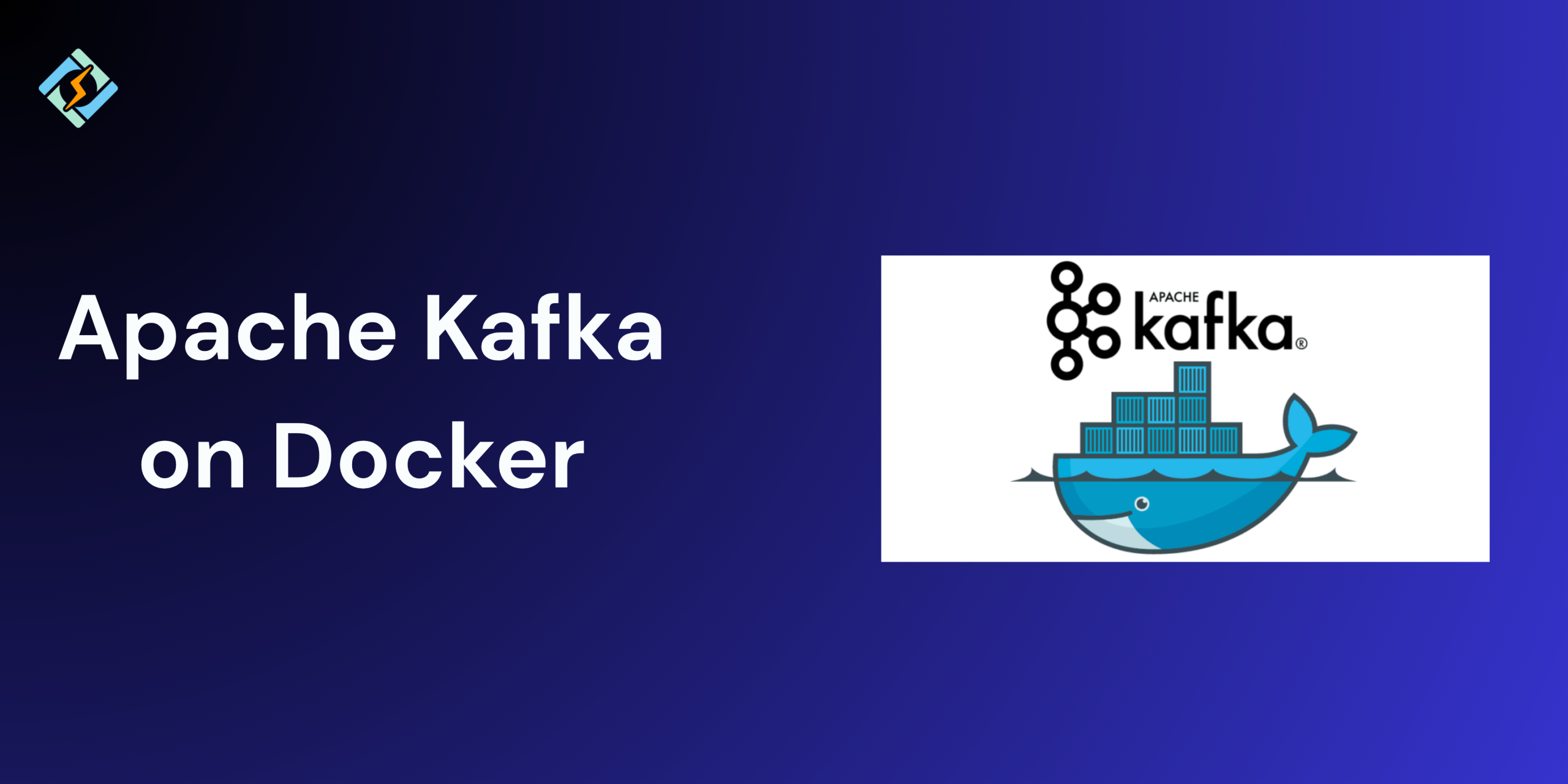Apache Kafka is a powerful open source platform that is used for building real-time data pipelines and streaming applications. Even though Kafka is highly scalable and fast, setting it up is quite time-consuming. This is where Docker comes in. Running Kafka on Docker simplifies the installation and the configuration process, which makes it easy to test locally, prototype, or even deploy lightweight environments.
In this guide, we will learn how to run Kafka on Docker.
Why Run Kafka on Docker?
Running Kafka on Docker has multiple benefits:
- No need to manually install Java, Kafka, or Zookeeper. Pre-built Docker images can handle the dependencies for you.
- Easily replicate the Kafka environments across different systems and teams.
- Keep Kafka and Zookeeper services isolated from the host system.
- Spin up and tear down Kafka clusters quickly for development and testing.
- Define Kafka, Zookeeper, and other dependencies in a single YAML file for orchestration.
Prerequisites for Running Kafka on Docker
Before you run Kafka on Docker, make sure that you have the following requirements ready.
- Install Docker on your system (Docker Desktop for macOS/Windows, Docker Engine for Linux)
- Basic understanding of Docker commands (e.g., docker run, docker ps)
- Sufficient system resources – at least:
- 2 GB RAM (4 GB recommended)
- 2 CPU cores
- Optional: Docker Compose, if you prefer managing multi-container applications using YAML
Installing Docker on macOS, Linux, or Windows
Here is how you can run Kafka on Docker according to your operating system.
macOS
- Download the Docker Desktop installer for mac and follow the instructions.
- After installation, run docker –version in Terminal to verify.
Windows
- Visit Docker Desktop for Windows
- Ensure WSL2 or Hyper-V is enabled.
- Install Docker and confirm using docker –version in Command Prompt or PowerShell.
Linux (Ubuntu example)
Run this command on the interface:
Get exclusive access to all things tech-savvy, and be the first to receive
the latest updates directly in your inbox.
sudo apt update
sudo apt install docker.io -y
sudo systemctl enable –now docker
sudo usermod -aG docker $USER
Then log out and log back in to apply user group changes.
For Docker Compose:
sudo apt install docker-compose -y
Using Docker Images for Kafka (Confluent vs Bitnami)
| Feature | Confluent Kafka Image | Bitnami Kafka Image |
| Maintained By | Confluent (original creators of Kafka) | Bitnami (by VMware) |
| Image Size | Larger | Lightweight |
| Ease of Use | High – includes CLI tools and full platform stack | Moderate – simpler, but more manual setup required |
| License | Confluent Community License | Open Source (Apache 2.0) |
| Ideal For | Enterprise-grade deployments, feature-rich dev environments | Local development, lightweight setups, open-source projects |
| Components Included | Kafka, Zookeeper, Schema Registry, KSQL, Control Center | Kafka, Zookeeper (optional), minimal extras |
| Configuration Options | More built-in options, integrated tools | Basic Kafka/Zookeeper config via environment variables |
| Docker Compose Support | Official examples available | Official and community examples available |
| Community Support | Strong – backed by Confluent with extensive docs | Good – active GitHub community and Bitnami support |
How to Install and Deploy Kafka on Docker
You can run Apache Kafka on Docker using two methods; by using the Docker CLI for a manual setup or using Docker Compose for managing multi-container applications. Here is how you can do it.
Using Docker CLI
This method runs individual commands to start the Kafka and Zookeeper containers.
- Pull Zookeeper and Kafka images:
docker pull bitnami/zookeeper:latest

docker pull bitnami/kafka:latest
- Start Zookeeper container:
docker run -d –name zookeeper \
-e ALLOW_ANONYMOUS_LOGIN=yes \
-p 2181:2181 \
bitnami/zookeeper:latest
- Start Kafka container:
docker run -d –name kafka \
-e KAFKA_BROKER_ID=1 \
-e KAFKA_ZOOKEEPER_CONNECT=zookeeper:2181 \
-e KAFKA_LISTENERS=PLAINTEXT://:9092 \
-e KAFKA_ADVERTISED_LISTENERS=PLAINTEXT://localhost:9092 \
-p 9092:9092 \
–network container:zookeeper \
bitnami/kafka:latest
However, you might need to use –network bridge and create a user-defined Docker network for better container communication in some setups.
Using Docker Compose
This is the normal approach to manage Kafka and Zookeeper together with clear configurations.
- Create a docker-compose.yml file:
version: ‘3’
services:
zookeeper:
image: bitnami/zookeeper:latest
container_name: zookeeper
ports:
– “2181:2181”
environment:
– ALLOW_ANONYMOUS_LOGIN=yes
kafka:
image: bitnami/kafka:latest
container_name: kafka
ports:
– “9092:9092”
environment:
– KAFKA_BROKER_ID=1
– KAFKA_ZOOKEEPER_CONNECT=zookeeper:2181
– KAFKA_LISTENERS=PLAINTEXT://:9092
– KAFKA_ADVERTISED_LISTENERS=PLAINTEXT://localhost:9092
- Start the containers:
docker-compose up -d
- Check if containers are running:
docker ps
Example: Docker Compose File for Kafka and Zookeeper
Here is a super simple docker-compose.yml file to run Kafka and Zookeeper using Bitnami’s official Docker images. This setup is ideal for local development and testing.
version: ‘3’
services:
zookeeper:
image: bitnami/zookeeper:latest
container_name: zookeeper
ports:
– “2181:2181”
environment:
– ALLOW_ANONYMOUS_LOGIN=yes
kafka:
image: bitnami/kafka:latest
container_name: kafka
ports:
– “9092:9092”
environment:
– KAFKA_BROKER_ID=1
– KAFKA_ZOOKEEPER_CONNECT=zookeeper:2181
– KAFKA_LISTENERS=PLAINTEXT://:9092
– KAFKA_ADVERTISED_LISTENERS=PLAINTEXT://localhost:9092
depends_on:
– zookeeper
Here is how you can use this file:
- Save the file under the name docker-compose.yml
- Now run the following commands to start Zookeeper and Kafka on Docker: docker-compose up -d
- Verify if the containers are still running, using: docker ps
- This setup will expose:
- Zookeeper on port 2181
- Kafka on port 9092
Make sure localhost:9092 works with your Kafka client. You may need to adjust the KAFKA_ADVERTISED_LISTENERS if you’re connecting from outside Docker.
How to Verify Kafka Is Running on Docker
Once Zookeeper and Kafka are up and running on Docker, you can verify the setup using a few simple steps:
- Check the running containers using the command: docker ps
- Both kafka and zookeeper containers should be listed and marked as “Up”.
- View the Kafka container logs using: docker logs kafka
- Look for messages like started (kafka.server.KafkaServer) indicating a successful start.
- Lastly, test the Kafka using the CLI:
docker exec -it kafka kafka-topics.sh –bootstrap-server localhost:9092 –list - If Kafka is running properly, it should just list the existing topics or return nothing if no topics are created yet.
Connecting to Kafka Inside Docker
Depending on whether the Kafka client is inside the Docker or running on your host machine, the settings might be different.
- If you are using it from another Docker container but on the same network, use the internal service name, for example: kafka:9092.
- If you are using a local machine, use: localhost:9092 if KAFKA_ADVERTISED_LISTENERS=PLAINTEXT://localhost:9092 is correctly configured.
- When you are using the Kafka CLI inside the container, using
docker exec -it kafka bash
kafka-console-producer.sh –broker-list localhost:9092 –topic test
Common Issues and Troubleshooting Tips
| Issue | Possible Cause | Solution |
| Kafka not reachable from host machine | Misconfigured KAFKA_ADVERTISED_LISTENERS | Set PLAINTEXT://localhost:9092 properly |
| Zookeeper connection error | Kafka can’t find Zookeeper | Ensure Zookeeper is running and KAFKA_ZOOKEEPER_CONNECT is correct |
| Topic commands hang or fail | Networking or port conflict | Check port 9092 availability and Docker bridge network settings |
| Kafka restarts or crashes repeatedly | Invalid environment variables or missing config | Review logs with docker logs kafka to identify startup issues |
| Host and container network mismatch | Incorrect Docker network settings | Use depends_on and Docker Compose’s default network for container linking |
Conclusion: Should You Use Kafka on Docker for Production?
Running Kafka on Docker is a really good option for development, testing, and CI workflows. It allows you a fast and repeatable setup that is super easy and needs only minimal manual instructions.
FAQs
Do I need Zookeeper to run Kafka on Docker?
Yes, Kafka requires Zookeeper to manage cluster metadata. However, newer versions (like KRaft mode) are moving toward Zookeeper-less architecture.
Which Docker image should I use for Kafka?
Popular choices include the Confluent Platform image (feature-rich, enterprise-grade) and Bitnami Kafka image (lightweight and open-source friendly).
How do I access Kafka running in a Docker container?
You can access Kafka on localhost:9092 if properly exposed and configured using the KAFKA_ADVERTISED_LISTENERSenvironment variable.



